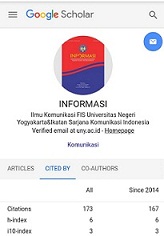Establishment of Universiti Muhammadiyah Malaysia (UMAM) in the perspective of communication for development through education modernization
DOI:
https://doi.org/10.21831/informasi.v53i2.64705Keywords:
Communication for Development, Modernization, Muhammadiyah, Malaysia, Universiti Muhammadiyah MalaysiaAbstract
Muhammadiyah is considered a radical conservative movement among the Malaysian Muslim community. The education system in Malaysia is generally exclusive. The majority of Malaysian society is resistant to the Muhammadiyah sect except in certain states. This research used the theory from Servaes and Malikhao, the modernization paradigm that influenced academia from 1945 to 1965 was supported by the transition of socio-political technology and culture from advanced societies to traditional societies. Development is explained as economic growth. The main idea in the modernization perspective shows that development is interpreted as first, planned, and overlapping. The results showed ideologically, the principle of progressive Muhammadiyah in establishing Universiti Muhammadiyah Malaysia (UMAM) cannot be separated from the role of the 47th Muktamar Muhammadiyah in Makassar. The congress was aimed at strengthening Muhammadiyah's Islamic vision, namely progressive Islam. Muhammadiyah launched an internationalization program, especially in the field of education, one of its implementations was by developing excellent educational centers abroad. Furthermore, Malaysia is considered the first step as a representative city center that excels in education and internationalization. Muhammadiyah is a movement that cares about Muslims so that they are not degraded by the progress of other nations, so public schools were founded and eventually became universities. This research concluded that the establishment of UMAM was a place to prove that Muhammadiyah is a progressive da'wah movement and builds society towards enlightenment. UMAM presents a superior lecture system with international standards through the use of technology. However, life is still based on Islamic values.
References
Abdul Mu'ti et al. (2015). Kosmopolitanisme Islam Berkemajuan: Catatan Kritis Muktamar Teladan Ke-47 Muhammadiyah di Makassar 2015. Muhammadiyah University Press.
Abdurrahman Ahmad et al. (2006). Himpunan Fadhilah Amal. Ash-Shaff.
Adeni, & Bakti, A. F. (2020). Reconceptualising the Elements of Islamic Propagation: Religious Response and Adaptation to New Media. Jurnal Komunikasi Islam, 10(2).
Agger, B. (2013). Teori Sosial Kritis: Kritik, Penerapan, dan Implikasinya. Kreasi Wacana.
Al-Hamdi, R., Irvan Mawardi, Neni Nur Hayati, & Moh Mudzakkir. (2022). Internasionalisasi Muhammadiyah Sejarah dan Dinamika Pimpinan Cabang Istimewa Muhammadiyah Luar Negeri 2002-2022. Samudra Biru.
Amalia, F., Setiawan, F., Salsabila, U. H., & Falikah, T. Y. (2022). Pendidikan Islam bagi Buruh Migran Dalam Amal Usaha Pimpinan Cabang Istimewa Muhammadiyah Malaysia. Muta'allim: Jurnal Pendidikan Agama Islam, 1(3).
Anam, M. Z., Ahmad Nubail Munir, & Radiva Rusyda Hidayat. (2022). Muhammadiyah Diaspora Diplomacy in Protecting Indonesian Migrant Workers in Malaysia. Jurnal Hubungan Internasional, 11(1).
Andi Faisal Bakti et al. (2020). A Faith Service Through the Guidance of the Qur'an and Sunnah: Positive Action. The 11th International Bediuzzaman Symposium.
Anggraeni, D., Sarwoprasodjo, S., Saleh, A., & Bakti, A. F. (2021). GAP Komunikasi Antargenerasi Dalam Pengelolaan Radio Komunitas Di Wilayah Urban. Jurnal PIKOM: Penelitian Komunikasi dan Pembangunan, 22(1).
Bakti, A. F. (1999). Newsflow and Civil Society during the Crises within the Malay World. Institute of Postgraduate Studies and Research, 2.
Bakti, A. F. (2000). The Contribution of Dakwah to Communication Studies: Risale-i Nur Collection Perspective. Review of Human Factor Studies, 6(1).
Bakti, A. F. (2002). Encyclopedia of Modern Asia.
Bakti, A. F. (2004). Communication and Family Planning in Islam in Indonesia: South Sulawesi Muslim Perceptions of a Global Development Program. INIS.
Bakti, A. F. (2008). Communication and Violence: Communicating Human Integrity Characteristics Is Necessary for Horizontal Conflict Resolution in Indonesia. Identity, Culture, and Politics, 9(1).
Bakti, A. F. (2011). Southeast Asia, Islamic Da'wa in. Oxford Journal, 5.
Bakti, A. F. (2013). Raising Public Consciousness About the Importance of Freedom of Expression in A Democratic Society and on Enhancing the Quality of Life of the Ordinary Citizen: The Case of Indonesia. The Journal of Development Communication , 24(1).
Bakti, A. F. (2014). Globalisasi Dakwah Cerdas Era Globalisasi: Antara Tantangan Dan Harapan. 4.
Bakti, A. F. (2018). Media and Religion: Rodja TV's Involvement in the Civil Society Discourse for Community Development. Malaysian Journal of Communication , 34(3).
Basya, M. H. (2020). Muhammadiyah Dan Salafisme Di Masa Transisi Demokrasi Indonesia. Suara Muhammadiyah.
Binangkit, I. D., & Siregar, D. I. (2020). Internasionalisasi dan Reformasi Perguruan Tinggi: Studi Kasus Pada Lembaga Pendidikan Tinggi Muhammadiyah. Jurnal Dinamika Manajemen Pendidikan, 4(2), 131. https://doi.org/10.26740/jdmp.v4n2.p131-138
Birowo, M. A. (2004). Metode Penelitian Komunikasi: Teori Dan Aplikasi. Gitanyali.
BPHN. (2012). Perbandingan Perseroan Terbatas Di Beberapa Negara. https://www.bphn.go.id/data/documents/pk-2012-1.pdf
Branston, G., & Stafford, R. (2010). The Media Student's Book (5th ed.). Routledge.
Brubaker, R. (1992). Citizenship and Nationhood in France and Germany. Harvard University Press.
Cederman, L.-E. (1997). Emergent Actors in World Politics: How States and Nations Develop and Dissolve. Princeton University Press.
Creswell, J. W. (2003). Desain Penelitian: Pendekatan Kualitatif Dan Kuantitatif. KIK Press.
Fadl, K. M. A. El. (2007). The Great Theft: Wrestling Islam from the Extremists. HarperOne.
Giddens, A. (1990). The Consequences of Modernity. Stanford University Press.
Guba, E. G. (1991). The Paradigm Dialog. SAGE Publications.
Hamka. (2015a). Tafsir Al-Azhar (Vol. 4). Gema Insani.
Hamka. (2015b). Tafsir Al-Azhar (Vol. 5). Gema Insani.
Hamka. (2015c). Tafsir Al-Azhar Jilid : Vol. Jilid 2. Gema Insani.
Haynes, P. (2012). Immanent Transcendence: Reconfiguring Materialism in Continental Philosophy. Bloomsbury.
Hostettler, S., Besson, S. N., & Bolay, J.-C. (t.t.). Technologies for Development From Innovation to Social Impact. Springer Open.
Jainuri, A. (2013). Muhammadiyah Dan Wahhabisme: Mengurai Titik Temu Dan Titik Seteru. Suara Muhammadiyah.
Junaidi, M. (2023, Juli 3). Personal Interview.
Kahfi, M. (2020). Peranan Muhammadiyah Sebagai Gerakan Islam Berkemajuan Di Era Modern. Al-Risalah, 11(2).
Kuhn, T. S. (1996). The Structure of Scientific Revolutions 3rd Edition. University of Chicago Press.
Kuntowijoyo. (1991). Paradigma Islam: Interpretasi Untuk Aksi. Mizan.
Lerner, D. (1958). The Passing of Traditional Society: Modernizing the Middle East. Free Press.
Littlejohn, S. W., & Karen A. Foss. (2007). Theories of Human Communication (9th ed.). Wadsworth Publishing.
McLuhan, M. (1964). Understanding Media. Signet Books.
Melkote, S. R., & Steeves, H. L. (2015). Communication for Development: Theory and Practice for Empowerment and Social Justice. SAGE Publications India.
Mistu, M. D. A.-B. M. (2003). Al-Wafi Syarah Kitab Arba'in An-Nawawiyah. Al-I'tishom.
Moleong, L. J. (2000). Metode Penelitian Kualitatif. PT. Remaja Rosdakarya.
Moyen, E. A. (2011). Frank L. McVey and the University of Kentucky: A Progressive President and the Modernization of a Southern University. The University Press of Kentucky.
Mughni, S. A. (2023, Juni 30). Wawancara Dengan Ketua Bidang Hubungan Dan Kerja Sama Internasional PP Muhammadiyah.
Mughni, S. A., Abd Mu'ti, Syamsul Arifin, Bambang Cipto, Tobroni, Najib Burhani, Pradana Boy ZTF, Subhan Setowara, Hasnan Bachtiar, & Nafik Muthohirin. (2022). Risalah Islam Berkemajuan Memajukan Indonesia Mencerahkan Semesta. Pimpinan Pusat Muhammadiyah.
Nashir, H. (2009). Manhaj Gerakan Muhammadiyah: Ideologi, Khittah, Dan Langkah. Suara Muhammadiyah.
Nashir, H. (2014). Memahami Ideologi Muhammadiyah. Suara Muhammadiyah.
Nugroho, D. A. (2023). Upaya Internasionalisasi Muhammadiyah Melalui Sektor Pendidikan: Studi Kasus Di Malaysia Tahun 2015-2021. Ganaya: Jurnal Ilmu Sosial dan Humaniora, 6(1).
Nuryana, Z. (2017). Revitalisasi Pendidikan A-Islam dan Kemuhammadiyahan pada Perguruan Muhammadiyah. Tamaddun: Jurnal Pendidikan dan Pemikiran Keagamaan, 18(1).
Picard, M. and R. M. (2011). The Politics of Religion in Indonesia: Syncretism, Orthodoxy, and Religious Contention in Java and Bali. Routledge.
Rahmayuni, D., Arief Tri Setiawan, & Andi Faisal Bakti. (2022). Islam Wasathiyah Value in Photojournalism in Guo Ji Ri Bao Newspaper. Islamic Communication Journal , 7(1).
Ridwan, W. (2023, Juni 3). Wawancara dengan Wakil Rektor Universitas Muhammadiyah Malaysia (UMAM).
Santoso, M. A. F. (2016). Internasionalisasi Konsep Purifikasi dalam Manhaj Tarjih Muhammadiyah. Muhammadiyah Studies, 1(1).
Schramm, W. (1964). Mass Media and National Development: The Role of Information in the Developing Countries. Stanford University Press.
Servaes, J. (2008). Communication for Development and Social Change. SAGE Publishing India.
Setiaji, B. (2023, Juni 27). Personal Interview.
Setyowati, Y. (2019). Komunikasi Pemberdayaan Sebagai Perspektif Baru Pengembangan Pendidikan Komunikasi Pembangunan Di Indonesia. Jurnal Komunikasi Pembangunan, 17(2).
Solomon, R. C. (2003). On Fate and Fatalism. Philosophy East and West, 53(4).
Subarkah, M. A. (2017). Muhammadiyah dan Amal Usaha di Bidang Pendidikan. Rausyan Fikr: Jurnal Pemikiran dan Pencerahan, 13(2).
Syaikh, A. bin M. A. (2015). Tafsir Ibnu Katsir (Vol. 4). Pustaka Imam Asy-Syafi'i.
Syakir, S. A. (2016). Mukhtashar Tafsir Ibnu Katsir (Vol. 3). Darus Sunnah.
Tim Penulis Dosen AIKA. (2018). Kemuhammadiyahan. Suara Muhammadiyah.
Tohirin. (2017). Konsep Dan Implementasi Pendidikan Karakter Di Universitas Muhammadiyah Prof. Dr. Hamka Jakarta. EDUKASI: Jurnal Penelitian Pendidikan Agama dan Keagamaan , 14(2).
UMAM. (2023a). About UMAM. https://umam.edu.my/about-umam/
UMAM. (2023b). Board of Directors. https://umam.edu.my/board-of-directors/
UMAM. (2023c). Board of Governors. https://umam.edu.my/board-of-governors/
UMAM. (2023d). E-Learning. https://umam.edu.my/e-learning/
UMAM. (2023e). Executive Management Committee. https://umam.edu.my/executive-management-committee/
UMAM. (2023f). Senate. https://umam.edu.my/senate/
UMAM. (2023g). Student Life. https://umam.edu.my/student-life/
Wardiyanto, W., Hasnidar Hasnidar, & Elilhami Elilhami. (2020). The Role of Muhammadiyah Education in Dealing with Bid'ah: E-Learning about Al-Islam and Kemuhammadiyahan. EduPsyCouns: Journal of Education, Psychology, and Counseling, 2(2).
Waskita, D. (2005). Komunikasi Pembangunan untuk Pemberdayaan. Jurnal Organisasi dan Manajemen, 1(1).
Wellman, C. (1979). On Terrorism Itself. The Journal of Value Inquiry, 13(4).
Yan, S. (2017). The Patterns of Symbolic Communication. Routledge.
Yuristia, A. (2017). Keterkaitan Pendidikan, Perubahan Sosial Budaya, Modernisasi dan Pembangunan. JUMANTIK (Jurnal Ilmiah Penelitian Kesehatan), 1(1).
Downloads
Published
How to Cite
Issue
Section
Citation Check
License
Authors who publish with this journal agree to the following terms:
- Authors retain copyright and grant the journal right of first publication with the work simultaneously licensed under a Creative Commons Attribution License that allows others to share the work with an acknowledgement of the work's authorship and initial publication in this journal.
- Authors are able to enter into separate, additional contractual arrangements for the non-exclusive distribution of the journal's published version of the work (e.g., post it to an institutional repository or publish it in a book), with an acknowledgement of its initial publication in this journal.
- Authors are permitted and encouraged to post their work online (e.g., in institutional repositories or on their website) prior to and during the submission process, as it can lead to productive exchanges, as well as earlier and greater citation of published work (See The Effect of Open Access).











